
|
|

January 22, 2010
WTOP Studios, Washington, DC, 2008
Welcome to the next installment in a multi-segment recap of a fun trip we took in the summer of 2008. The ostensible purpose of this particular week on the road was to take Ari, then not-quite-five, on a "daddy-daughter trip" to Washington to celebrate her brand-new status as a big sister, but she took one day off from tourism to hang out with family friends while Daddy made the rounds of some well-known broadcast facilities in Our Nation's Capital.
One important stop was at 3400 Idaho Avenue, in a residential neighborhood in northwest DC, to see the "Glass-Enclosed Nerve Center" that's home to Bonneville's all-news powerhouse WTOP and its sister stations. We'd visited here once before, in the early nineties, when WTOP's original studio facility at this site was still fairly new (the station moved here in 1986 after seven years at 4646 40th Street NW, around the corner from its longtime Broadcast House home on Brandywine Street), but on this sweltering August day, WTOP was still settling in to a completely renovated studio and newsroom space that we'd heard lots of good things about.
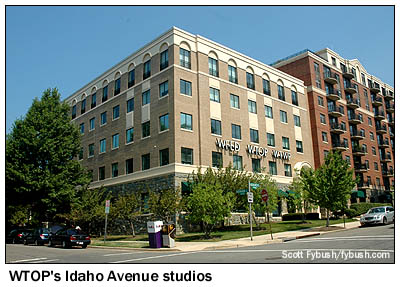
|
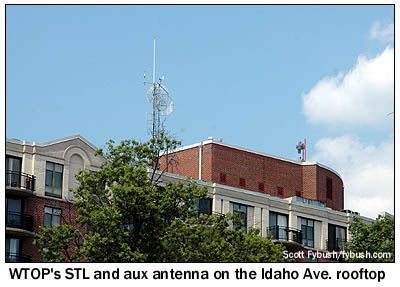
|
Our tour actually began on the ground floor of the building, in space once occupied by classical station WGMS-FM (103.5, later 104.1). In 2008, this space was being used by two Bonneville AM stations: "Federal News Radio" WFED (1050 Silver Spring MD) and talk radio "3WT," which was occupying WTOP's former dial positions at AM 1500 in Washington (WWWT), AM 820 in Frederick (WWWB) and FM 107.7 in northern Virginia (WWWT-FM Manassas).
3WT's days were already rumored to be running short when we visited, and the renovations that were underway on several studios in the ground-floor complex left little doubt that Federal News Radio would soon be expanding - and indeed it did: just six weeks after our visit, 3WT was history, Federal News Radio had moved up the dial to the 50 kW AM 1500 facility (and to 820 in Frederick), while 107.7 was added back to the WTOP simulcast and 1050 was leased out to Air America, becoming WZAA. (They're looking for a new format today!)
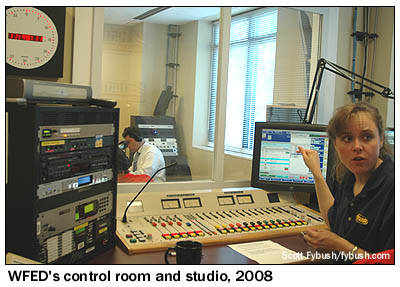
|
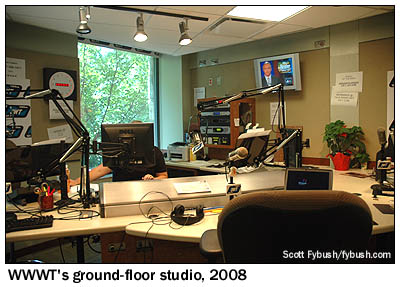
|
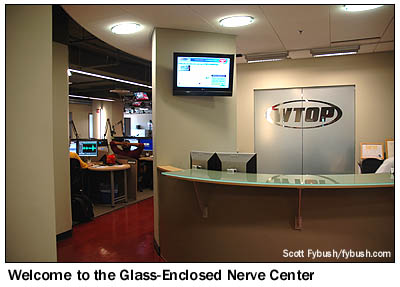 Up
we go to the second floor, and here's where the big renovations
had just wrapped up. From the fall of 2007 until March 2008,
WTOP's news staff moved out of this space so it could be gutted
and completely rebuilt, and we heard some horror stories about
the cramped studios down the hall that WTOP used in the meantime.
Up
we go to the second floor, and here's where the big renovations
had just wrapped up. From the fall of 2007 until March 2008,
WTOP's news staff moved out of this space so it could be gutted
and completely rebuilt, and we heard some horror stories about
the cramped studios down the hall that WTOP used in the meantime.
Bonneville spent $2.5 million on the renovation, and it's a nice space indeed.
Beyond the lobby, several walls were removed to create a larger newsroom with more working space for WTOP's reporters. Managers remained in place along the outside wall (to the left from the lobby desk), and a new ingest area was created between the managers' offices and the newsroom. This space (seen just below) is the functional equivalent to the old "tape op" area where your editor got his start in radio news - except instead of tape, all the incoming sound from network feeds, field reporters and other outside sources is going into a computer. (What? No bulk-eraser and stacks of carts?)
To the left of the editor at the ingest station is a separate studio for WTOP's traffic reporters, including DC's "Dean of Traffic," Bob Marbourg. (This space can double as a TV studio as well.)
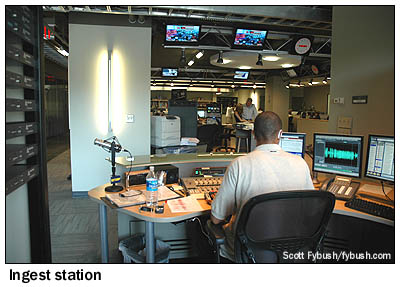
|
|
The heart of the new operation, of course, is the editor's desk, which faces into the studios through a nearly floor-to-ceiling glass wall. When we visited, only one of the two studios had been completed, and it's a nice spacious area with much more room for co-anchors, interview guests and reporters than the old studio offered. Another room next to the two air studios is a green room (for some of the prominent visitors who stop by WTOP) that can also double as an interview space, a conference room and a TV studio.
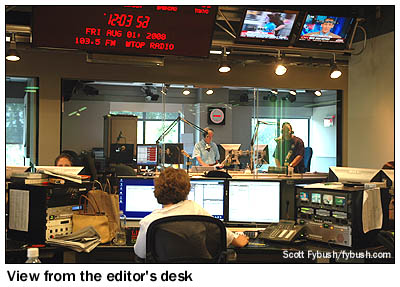
|
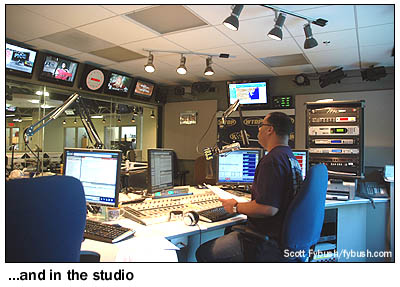
|
Down the hall from the newsroom and studios is the production suite that doubled as WTOP's temporary on-air studio during the 2007-2008 renovations, and down the hall from that is the new rack room, full of servers and STL gear to get WTOP's signal out to its many far-flung transmitter sites.
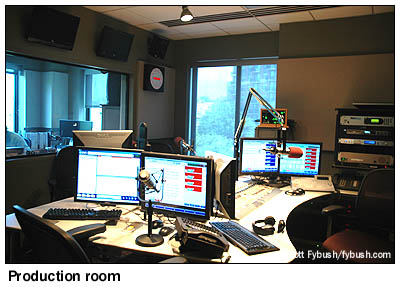
|
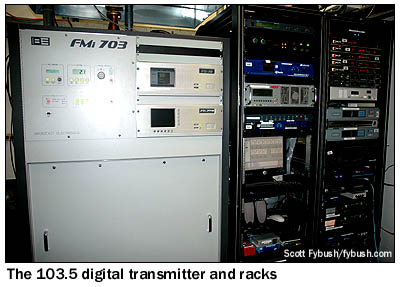
|
The most near-flung (is that a word?) of those sites is just a half-mile or so to the west, where WTOP-FM sends out its main 103.5 signal from the tower on the American University campus off Massachusetts Avenue that was originally built for the old WMAL-TV 7 when it signed on in the late forties. WTOP is one of three FM signals that use this tower for their main signals; it's also an aux site for WPGC (95.5), which uses that two-bay antenna at the very top of the tower. (That's American University's WAMU 88.5 on the six-bay Shively just below, which shares an aperture with WTOP's three-bay Shively on the opposite side, and Pacifica's WPFW 89.3 on the 10-bay side-mounted antenna.)
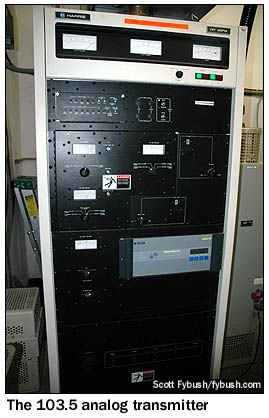
|
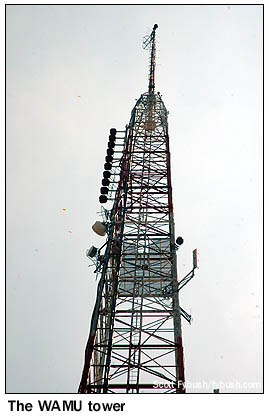
|
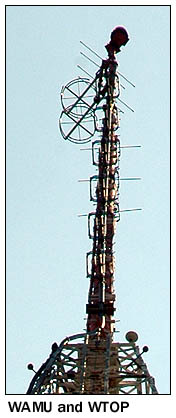
|
In addition to the main site at the AU tower, WTOP also has a full-power aux facility at the AM 1500 site, which we'll show you again next week (while we're traveling out west, gathering new material for future San Francisco Sites of the Week), and a last-resort aux facility on the roof of the Idaho Avenue building that was originally intended as a booster for the 104.1 signal that Bonneville has since sold.
This series of Site of the Week installments is once again accompanied by weekly ID updates over at our sister site, TopHour.com. Stop by on Wednesday, Jan. 27 for the first of two big batches of Washington IDs...and in the meantime, don't miss your chance to grab one of the dwindling remaining stash of the all-new Tower Site Calendar 2010, just in time to fill that space on the wall where your 2009 edition once hung.
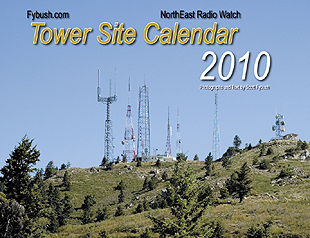 (It's
more than just pretty pictures and dates - the modest sum we
raise from each year's calendar helps make possible the travel
needed to make this feature happen every week on the website...and
we're grateful for all your support!)
(It's
more than just pretty pictures and dates - the modest sum we
raise from each year's calendar helps make possible the travel
needed to make this feature happen every week on the website...and
we're grateful for all your support!)
- Previous Site of the Week: Baltimore, 2008 (part II)
- Next Week: WFED (WTOP) 1500 transmitter, Washington
- Site of the Week INDEX!
- How can you help support Site of the Week? Click here!
- Submit your suggestions for a future Site of the Week!
